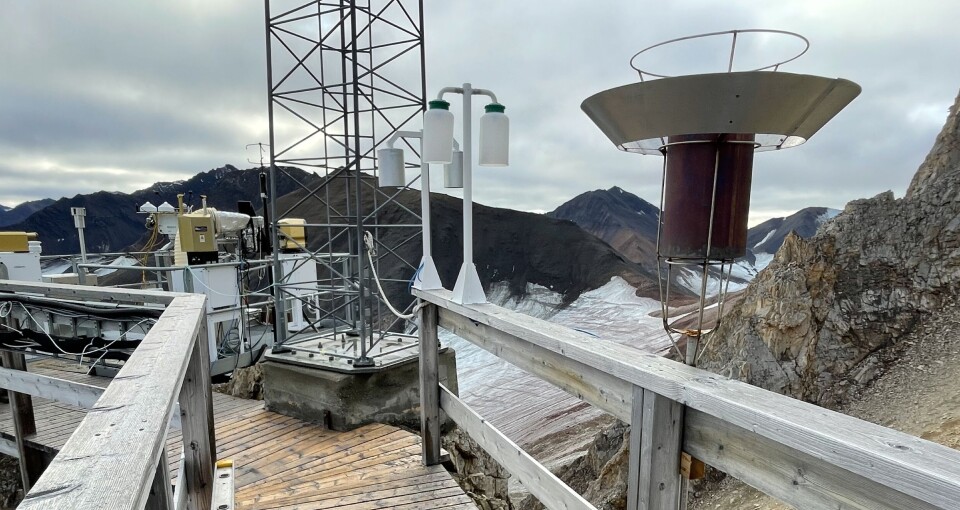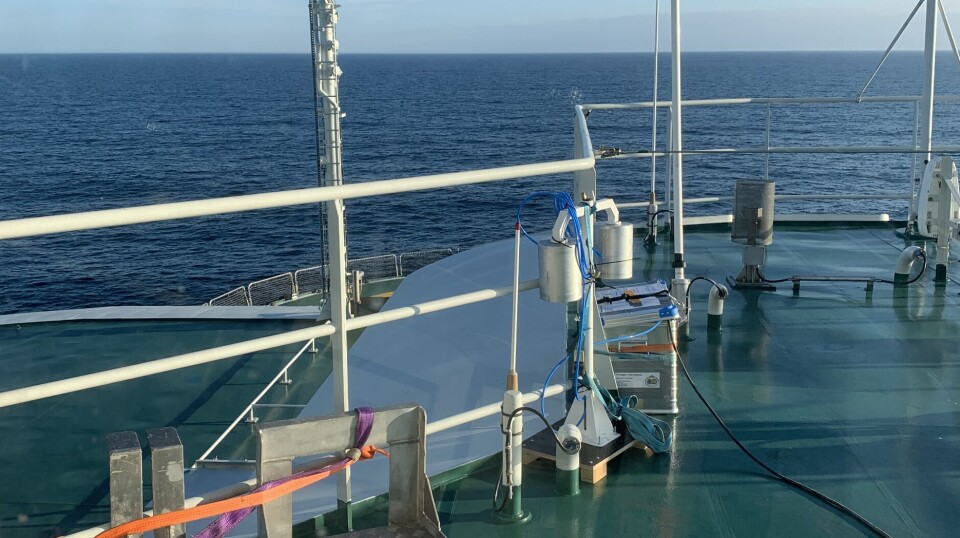THIS ARTICLE/PRESS RELEASE IS PAID FOR AND PRESENTED BY NILU - Norwegian Institute for Air Research - read more

Researchers find microplastics in the air using aluminium buckets and 600-degree heat
Have you used the car lately? Or perhaps washed clothes? In any case, the chances are high that you have released microplastics into your immediate environment. It can fly all the way to Svalbard.
Microplastics are plastic fragments smaller than 5 millimetres. There are many sources of microplastics: car tyres, clothes, fishing gear, cosmetics, toys, boats, tools – and a lot of other things we use in our everyday lives.
A lot of microplastics also come from plastic waste that has been lost in nature and broken down into tiny pieces.
Other types of microplastics are produced industrially, for example to be used in make-up, which we apply and then wash off down the drain.
Developed their own air samplers for microplastics
Since the microplastic pieces are so small and light, they can be transported through the atmosphere by water and wind far, far away. They also end up in areas where few people live.
In the summer of 2021, Dorte Herzke from the Norwegian Institute for Air Research (NILU) participated in the Norwegian Polar Institute’s Plastic Cruise expedition in the sea areas off Svalbard. Along the way, the scientists took 1,200 microplastic samples from air, ice, water, fish, plankton, and the seabed.
The Plastic Cruise was the first time Dorte Herzke used the sampler for microplastics in air developed by NILU.
It was the now retired NILU scientist Svein Knudsen who helped Herzke develop the microplastic sampler.
The microplastic sampler is based on a similar sampler NILU previously developed for taking samples of other substances in the air. The principle is the same, but in the new microplastic version, all the plastic sampler components have been replaced with metal.
“We can’t take microplastic samples with plastic equipment,” Herzke says. “If we did, we’d contaminate our samples. Therefore, our first air sampler for microplastics was made from stainless steel. Later we switched to aluminium.”
Svalbard influenced by microplastics
In autumn 2021, NILU mounted two different microplastic samplers at the Zeppelin observatory. The observatory is located 474 metres above sea level, near the top of Zeppelin Mountain on Svalbard.
The nearest settlement is the research village Ny-Ålesund. In winter, only around 30 people live there. During summer, it's up to 200.
Even there, the filters in the samplers picked up tiny plastic pieces, down to a hundredth of a millimetre.
“Unfortunately, I was not surprised,” Herzke says. “We think of Svalbard as untouched and desolate, but microplastics find their way to this remote area too.”
The six microplastic air samples NILU took during autumn 2021 were part of the Norwegian Environment Agency’s monitoring project for microplastics, MIKRONOR. In 2022, NILU financed its own tests.
According to Herzke, the goal is to determine if the results from 2021 can be repeated, and also whether the results look different during the summer period.
“We now have samples from both the winter and summer seasons at the Zeppelin observatory,” she says. “We are also taking corresponding microplastic samples at the Birkenes observatory in the south of Norway.”

Smart solutions are needed
Two kinds of microplastic samplers have been developed by NILU. One is a ‘passive’ sampler. It is essentially a large metal bucket that collects everything that falls from the sky.
The other air sampler for microplastics – the one Dorte Herzke used on the Plastic Cruise – is an ‘active’ sampler. It uses a pump to draw air through filters, capturing all particles larger than a hundredth of a millimetre.
Every 14 days, the filters in the active samplers at Zeppelin and Birkenes observatories are replaced.
Herzke is particularly pleased that they were able to design the filter holder so that it closes immediately when it is removed. In this way, they avoid contaminating the filter inside with plastic from sources other than the air.
The entire filter holder can be packaged and sent to NILU’s laboratory in Tromsø, where Herzke and her colleagues are ready to do the analysis.

600°C reveals the microplastic
The microplastics on the filters are too small to be seen with the naked eye. So how does Dorte Herzke know that there is microplastic on the filter?
“We don’t know, and we can’t even use a microscope to look for it,” she says.
Instead, the researchers use an instrument called a mass spectrometer (GC/MS) and connect it to a pyrolysis unit.
Although ‘pyrolysis’ makes it sound like they are burning the samples, that is not what is happening. The filter samples must be exposed to 600-degree heat to reveal the microplastic.
But without oxygen present, combustion does not occur. Instead, a process called pyrolysis takes place, where the polymer structure, i.e., the repetitive bond between each molecule in the plastic, is destroyed.
Since different types of plastic break down into different polymer structures, scientists can measure and classify the different structures into different types of plastic and determine how much there is of each kind.
Tracking microplastics through the air
When Dorte Herzke began to take an interest in plastic pollution, and later microplastics, most measurements were done on samples from animals and fish.
She eventually became more interested in what happens to the microplastics in the environment, and which transport routes they take to the Arctic. With funding from the Fram Centre, NILU, and the Norwegian Environment Agency, she was able to start looking for answers.
“After all, air is NILU’s home ground,” she says. “As soon as we started looking at microplastics in the context of air, collaborating with other NILU departments was initiated. Together, we can both determine that there is microplastic in the Arctic and calculate how it was transported through the atmosphere to get there.”
Filters from microplastic sampling at the observatories in Svalbard and Agder are still coming in. Analysis and further studies of these will fill a lot of Herzke’s time in the future. But she can already say that this time, too, there is plastic in the air.
This article was first published in Fram Forum 2023.

This article/press release is paid for and presented by NILU - Norwegian Institute for Air Research - read more
This content is created by NILU's communication staff, who use this platform to communicate science and share results from research with the public. NILU is one of more than 80 owners of ScienceNorway.no. Read more here.
See more content from NILU:
-
Summer in Central Europe: Drought and wildfires to be expected
-
How do you design a healthier place to live?“I would prioritise easy, car-free access to everything you need in your daily life"
-
Fires in tropical forests affect more than just the forests
-
Engineer Sam Celentano found 222 grams of gold in a laboratory. What was it doing there?
-
Air pollution levels are still too high across Europe
-
Researchers have discovered how biological particles affect the clouds over the Arctic




































